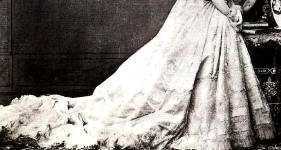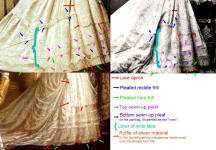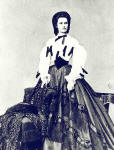– Edited to add:
During to a flood that hit my house, the fabrics and partially completed parts of this costume were destroyed.
So until I decide to actually redo everything with new fabrics, the pages for this gown only serve as a documentation and memory of what I made; not as a dress diary.
As I have written on the studying page:
| I want…:- the skirt from the photograph:
but without the court train, and most definitely without that lace apron. I think I can also live very happily without the veil. |
In short terms… my skirt will have:
blue, green, pink, purple and turquoise and can live without orange and red.
So… the making of the skirt started by getting an idea for the skirt’s pattern.
The lace decorations have been sewn to the cross grain, resulting in the well visible fact that they seem to „curve“ down to the sides of the skirt – which is just a result of them being sewn on the cross grain of the curved front pattern shape:
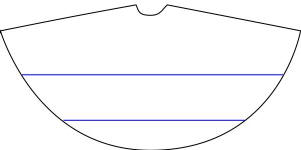
Shape of the front pattern piece of the skirt. Black indicates cutting lines; blue indicates the placement of the top pleated frill and first sewn-in pleat.
(waistline is not correct, but the basic layout of the hem and the lace decorations is)
A much likely layout of „decorating the skirt on the cross grain and letting the decorations run out to the hem“ can be seen in a different photograph of Elisabeth:
And just because I already had the fabric which I wanted to use for the skirt – duchesse silk, bought at a sale for incredible EUR 6 / $8 per yard (!) – already at hand and had a few hours to sew the base of the front…
Here’s a picture of that front part of the skirt pinned to my dress mannequin. I’ve already sewn in the pleats and the small pleated frill to the middle of the front, but have not added any lace yet and the bottom hem frills are also still missing, so the skirt will seem to be too short – in fact, it’s just the right length.
The arrangement of pleats along the waistline is also not yet correct – that’s subject to change as soon as I have also made the back portion of the skirt 😉
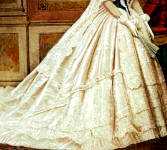
As you can probably see compared with the original skirt, my skirt drapes much likely, even if the bottom frills are still missing and so the skirt hem doesn’t have the correct length yet.
The material is also not ironed in any way, which is why it still has some pleats and folds from storage of the material.
The skirt was draped over the farthingale of my „Pelican gown“. While this is definitely not be the correct crinoline shape to be worn with this gown, it was still good enough for a first draping of the front portion of the skirt.
I do have to say that silk duchesse, while probably being the most beautiful silk material available, is unbelievable nasty to sew.
It frays and is slippery like mad.
It’s wonderful to iron, though – but beware of ironing any pleats into the fabric where they don’t belong; you’ll almost never be able to get them out again!
It absolutely *hates* water, so while steam ironing something like hem frills, don’t dare to drop water on the fabric – it will leave a stain.
Oh, and the fabric doesn’t forgive pinning with anything else than finest etymologist’s pins, or the holes from pinning will be visible forever…
Oh, and did I mention that this fabric is a dirt magnet? Don’t dare touch it without thoroughly scrubbed hands, better white cotton gloves!
(This is just something I had to write down in order to get rid of my frustration from working with that fabric!)
I would guess that this front pattern piece is at least 4 yards wide on the original skirt. Mine is „just“ three yards wide, as I „only“ have 9 meters / about 10 yards of that fabric for the complete skirt and gown bodice, of which, as unbelievable as it might sound, more than 2 yards will already be needed for just the hem frills – more on that subject later…
Here are some pictures of the skirt with the lace attached. The bottom frill is just pinned and pleated, but not ironed into frills yet.
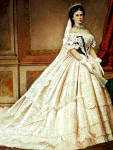
Skirt front/side view.
Note that even if the skirt is still draped over the wrong farthingale instead of a hoopskirt of correct shape and the breadth of my front pattern piece is approximately one yard smaller than on the original gown, it still drapes considerably beautiful.
If you take a *very* close look, you’ll be able to see a rust stain at the bottom of my lace decoration – well, that’s something vintage lace has sometimes…
You’ll then probably also notice some gaps between the hem frill and the skirt – as already mentioned, it’s just pinned, not sewn; and it already took 30 pins to pin that frill only every 8 inches…
There seems to be something like a seam over the middle frill (over the lace) – that’s just still a pleat from storage in the fabric, which I have still not ironed.
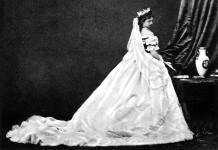
Skirt side/back view.
Again – the farthingale / hoopskirt problem; I have stuffed a bit of fabric under the skirt at the back to form a slight „bustle“ kind of look; however, that didn’t help me much in widening the bottom back of the farthingale, which is still the wrong undergarment for this skirt…
Note, again, how good the shape works compared with the original gown, even if the court train – as already announced – is missing from my gown as I don’t want it.
Again… some gaps visible between hem frill and skirt base; this still results from the not yet ironed frill just being pinned.
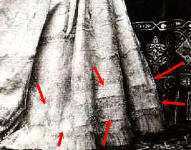
Picture of the two sewn-up pleats under the lace decorations.
Those are well visible under the lace in the photograph of the original gown, but as my lace is less sheer, it’s almost impossible to see them without lifting the lace up, as I am doing in this picture.
In my opinion, they’re not just there for decoration but also stabilize the front of the skirt.
The hem of my skirt is 6 meters / about 6.5 yards wide, the skirt being made of four breadths of my fabric. I guess that the original gown had a hem width of at least 9 meters / 10 yards; but most of that hem would have been needed for the court train. I think my skirt is just about 2-3 yards too small at the hem, which, taking the actual width and the missing court train into consideration, is not too much.
However, 6 meters / 6.5 yards of hem resulted in the fact that the frills for that hem – which are three times as long, if not pleated up – took 18 meters / almost 20 yards of 20cm / 8 inch wide fabric.
As my fabric was 150cm / 60 inch wide, this resulted in a total amount of 2.4 meters / 2.7 yards of fabric that I had to use for those frills. I’ve sewn and ironed all frills with my own hands, this work alone took a whole day.
So – as often, just for the statistics:
Work time for this skirt, including writing up the studying page (incl. partial studying, as I had studied the dress in parts already two years ago), constructing a skirt pattern, cutting, draping and afterwards sewing the skirt, pleating and sewing, but not ironing the hem frills – two days (= a whole weekend, with breaks).
Ironing the frills – another four hours (with breaks), sewing those frills to the skirt – another hour, and another two hours for finishing all seams etc.
This results in about 25 hours of work for this skirt, including close study, writing up this and the studying page.
If the bodice can be finished as fast as the skirt, my calculation will most definitely have to be revised…
Here’s the finished result – draped over a crinoline (hem circumfence: 420cm / about 4.5 yards) this time; but it is a round crinoline instead of the correct elliptical crinoline which would be needed for this skirt in order to achieve the portrait / photographs look. I have, however, arranged the crinoline in a way that it vaguely resembles an elliptical crinoline.
The waistband is still missing – I still need the exact waist circumfence, which I can just find out by making the bodice first (and, yes – that skirt is *huge*!):
Some detail pictures of the skirt, one of them showing the rust stain in the lace. And, yes, I am totally in love with the beautiful frilled hem 🙂
Evolution of the skirt during the making…:
What I don’t like so far:
The rather plain appearance of the skirt. Honestly, it almost looks to me like a simple bridal skirt – giant bridal skirt, but yet and still… bridal skirt.
I’m really thinking about decorating the lace with rhinestones or embroider it with silver threads. Hmmm, I could outline each flower in silver and decorate the center of each with a rhinestone… I think that’s a rather nice plan.
Will see if my funds allow rhinestones and my time allows silver threads until the gown is completely finished;-)
I am also a bit scared about that frilled hem wiping over the floor.
The dry-cleaning of that skirt will well cost a fortune, and I’m not willing to pay that, for example, after just taking some pictures of the gown.
I’m seriously thinking about adding a detachable layer of cotton frills below those silk duchesse frills. For practical reasons, I would simply sew a strip of velcro tape to the skirt, at which I could attach such a cotton frill (soft side in the skirt, hook side on the cotton frills).
I have an idea where to get cotton frills relatively cheap, but have no idea when I can get there.
Most fun thing while making the skirt:
Draping the front piece because I saw that my estimation of the lace arrangement was correct.
Most annoying things:
Why, sewing silk duchesse, of course. Especially the fraying almost drove me mad – threads everywhere… I think I have well picked two spools of thread from that material, which emerged through each and every seam while sewing…
Oh, and sewing / ironing the frills – at some point of time I thought about giving up and save for a professional pleater who could do the work for me…
And now… let’s start with the bodice.
